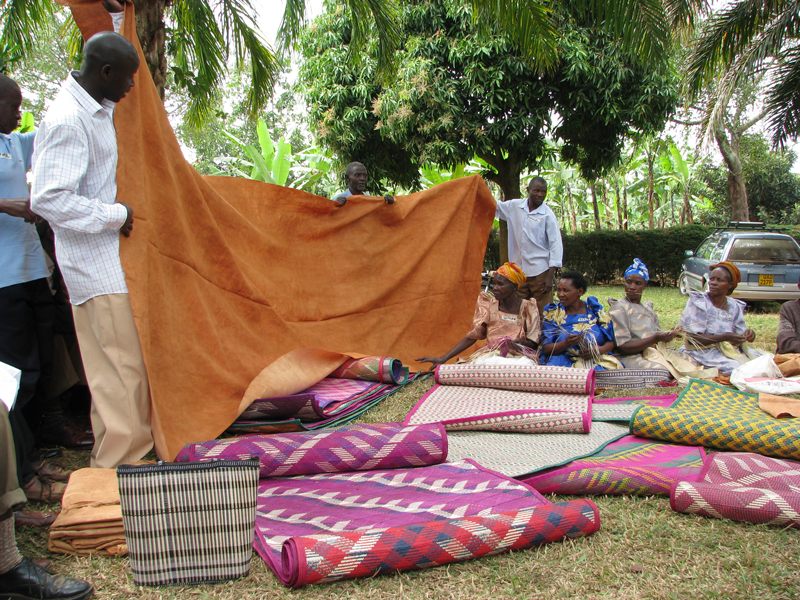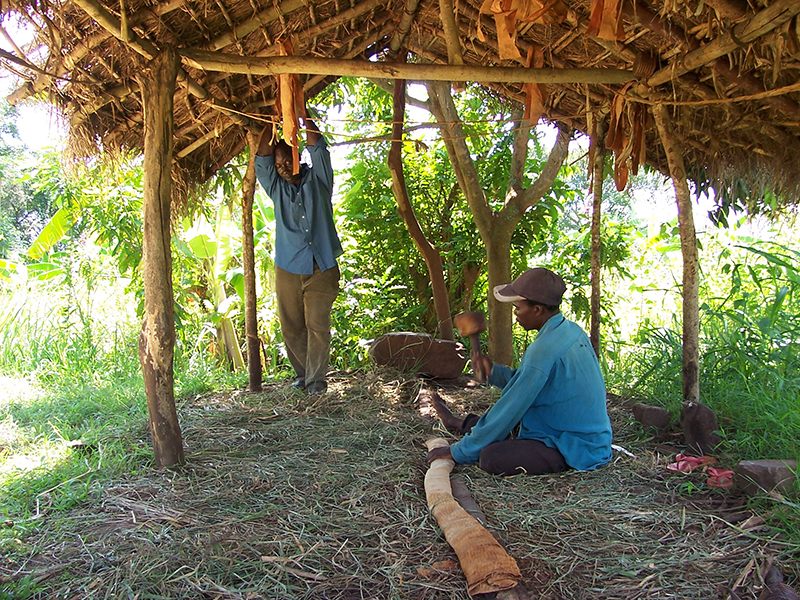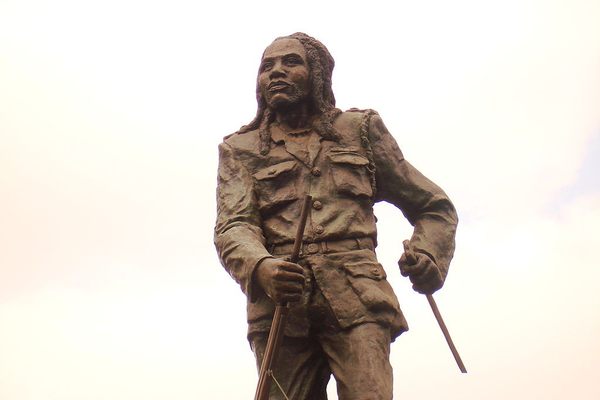A New Life for Ugandan Barkcloth, a Fabric Made From Fig Trees
The ancient textile has survived wars, colonialism, and global trade.

It takes strength, stamina, and practice to make traditional Ugandan barkcloth. The producers of this surprisingly soft and supple material first scrape away the outer bark of fig trees called mutuba (usually Ficus natalensis), then slit inner bark with a knife and peel it upward off the tree. They boil the bark in great pans of water to soften it, and then pound it for several hours with heavy wooden mallets until it is much, much thinner, wider, and softer. The cloth is dried in the sun, where it darkens to a ruddy brown, while the exposed trunk is wrapped in banana leaves for a few days to protect it as new bark grows, for another harvest.
Across the tropics, people worked out long ago how to transform fig tree bark into comfortable cloth—the practice could even predate weaving. In Uganda, barkcloth has served as a symbol of protest, a form of money, and the exclusive raiment of kings and queens. It has been suppressed by religion, colonialism, and war, yet the tradition has persisted, and now barkcloth has found a new life as a source of local pride, as well as in international markets for home furnishings, high fashion, and even aerospace materials. It is creating jobs, and is entirely sustainable.

In her doctoral thesis on the history of the textile, Venny Nakazibwe of Makerere University says the material has served as “a connecting thread” between past and present generations, but that its role and meaning has been in flux, based on the “dynamics of the social, economic, cultural and political structures at a given historical moment.”
While myths and legends surround the origin of the craft, historians date it back to the reign of Kimera, who ruled Uganda’s Buganda Kingdom from around 1374 to 1404. Then, only royalty wore barkcloth, but as news of the product spread, demand—and prices—grew. In the late 18th century, King Ssemakookiro ruled that all his subjects must produce it. Trade flowed and the Buganda Kingdom grew rich. The felt-like fabric became more common, as an everyday cloth, worn as a wrap or toga-style, and for use in religious ceremonies and as burial shrouds. Farmers used it to pay land taxes.

The emissaries King Muteesa I sent to London in 1879 presented gifts of barkcloth to Queen Victoria. But within fifteen years, Victoria’s empire had absorbed the land of barkcloth and folded it into the newly formed British Protectorate of Uganda. The colonial rulers had little use for the industry. They compelled farmers to produce cotton for English mills instead, stopped the practice of paying taxes in barkcloth, and banned traditional religion. Missionaries even called the fabric “satanic” and handed out imported textiles to discourage its use.
During World War I, the British felled more than 115,000 barkcloth trees to secure the border with German East Africa. Many skilled barkcloth producers had to emigrate. Nakazibwe says that those who stayed were compensated—but only after three years and what she terms a “painful process.” After the war, farmers began planting more barkcloth trees to boost yields of coffee plants with their shade, but when the British conscripted all local men under 45 to serve in the military during World War II, barkcloth production ground to a near halt.

Woven textiles had come to dominate the market, but a new role awaited barkcloth—it became a symbol. In 1953, when the British arrested King Muteesa II and sent him to England, many people began wearing the cloth again to express loyalty to the king and anger at the colonial administration. When he was finally allowed back in 1955, his supporters erected barkcloth-covered arches emblazoned with triumphal messages, and waved barkcloth banners along the 19-mile route from the airport to his palace.
Seven years later, Uganda gained its independence. In the following decades, the barkcloth industry rode waves of political crisis, dictatorship, civil war, and the end of the institution to which barkcloth was most closely tied—the subnational Buganda monarchy, its original patron. When it was restored in 1993, the new King Ronald Mutebi II wore ceremonial barkcloth at his coronation. The festivities entailed widespread use of barkcloth throughout the kingdom, sparking renewed interest in the material.

“Today, barkcloth has potential both for artistic expressions and industrial mass production of items for economic ventures, not only in Uganda but globally,” says barkcloth scholar Catherine Gombe. “The knowledge and skill of barkcloth production continues to be handed down to the younger generation through the informal education of apprentices.”
A new wave of artisans now fashion barkcloth into clothes, shoes, and bags. Designers have turned it into wallpaper, lampshades, and furniture. Zandra Rhodes shaped it into haute couture. Architect Zaha Hadid called it an “exceptional material.” And when the leaders of the G7 nations met in Germany in 2015, they did so in a room with walls covered in decorative barkcloth.

That barkcloth was supplied by Ugandan-German couple Mary Barongo-Heintz and Oliver Heintz, who have been in the business since 1999. They found early in their enterprise that the cloth itself is just the start—it can be dyed, rubberized, bleached, or hardened. By blending it with other materials, they could make it water repellent, fire retardant, or abrasion resistant—presenting a range of alternatives to leather or synthetic, petroleum-based materials.
“Money really does grow on trees,” says Heintz. His company BarkTex now sources barkcloth from 600 small-scale farmers in Uganda, and employs 50 more local people to upgrade the barkcloth, with priority given to women. “Many of our women workers earn an income far higher than their husbands,” says Heintz.

But under some traditional rules, women can be frozen out of the industry. In Baganda culture, the barkcloth tree symbolizes male power and ownership of land, and it is taboo for women to plant the trees. The Center for International Forestry Research and the Association of Uganda Professional Women in Agriculture and the Environment have now helped 50 women negotiate with their husbands to allow them to plant barkcloth trees. It’s a small move, but a start.
Heintz estimates that at least 500,000 farmers in Uganda could provide bark, with their income benefiting roughly 4,000,000 people. There are broader benefits. The trees store carbon. Their leaves provide fodder for livestock, their figs help sustain wildlife. Barkcloth production requires little energy or water and is carbon neutral.
In 2007, Gombe and her fellow researcher Celia Nyamweru reported that concerned Baganda elders feared their fig trees would outlive the knowledge of how to make barkcloth. Today, Gombe says, barkcloth’s “future is bright.”













Follow us on Twitter to get the latest on the world's hidden wonders.
Like us on Facebook to get the latest on the world's hidden wonders.
Follow us on Twitter Like us on Facebook